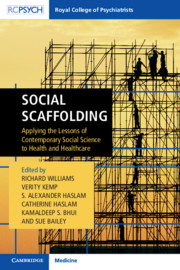Book contents
- Social Scaffolding
- Social Scaffolding
- Copyright page
- Contents
- Contributors
- Foreword
- Note
- Section 1 Schooling
- Section 2 Scoping
- Section 3 Sourcing
- Section 4 Scaffolding
- Chapter 23 Making Connectedness Count: From Theory to Practising a Social Identity Model of Health
- Chapter 24 Public Health Values and Evidence-Based Practice
- Chapter 25 Social Scaffolding: Supporting the Development of Positive Social Identities and Agency in Communities
- Chapter 26 Synthesising Social Science into Healthcare
- Chapter 27 Relationships, Groups, Teams and Long-Termism
- Chapter 28 Caring for the Carers
- Chapter 29 The Importance of Creating and Harnessing a Sense of ‘Us’: Social Identity as the Missing Link Between Leadership and Health
- Chapter 30 Smithtown as Society
- Section 5 Sustaining
- Index
- References
Chapter 25 - Social Scaffolding: Supporting the Development of Positive Social Identities and Agency in Communities
from Section 4 - Scaffolding
Published online by Cambridge University Press: 14 June 2019
- Social Scaffolding
- Social Scaffolding
- Copyright page
- Contents
- Contributors
- Foreword
- Note
- Section 1 Schooling
- Section 2 Scoping
- Section 3 Sourcing
- Section 4 Scaffolding
- Chapter 23 Making Connectedness Count: From Theory to Practising a Social Identity Model of Health
- Chapter 24 Public Health Values and Evidence-Based Practice
- Chapter 25 Social Scaffolding: Supporting the Development of Positive Social Identities and Agency in Communities
- Chapter 26 Synthesising Social Science into Healthcare
- Chapter 27 Relationships, Groups, Teams and Long-Termism
- Chapter 28 Caring for the Carers
- Chapter 29 The Importance of Creating and Harnessing a Sense of ‘Us’: Social Identity as the Missing Link Between Leadership and Health
- Chapter 30 Smithtown as Society
- Section 5 Sustaining
- Index
- References
Summary
This poem, by the Irish poet and Nobel Laureate, Seamus Heaney, is as applicable to sustaining healthy communities as it is to sustaining marital harmony, which is the purpose for which it was originally written. As the scaffolding provided the foundational structure from which Heaney and his wife built the walls of their marriage, so too we can develop communities through our own collective efforts, drawing on support from health and social care practitioners of various persuasions where and when required. Once it is established, we can gain confidence from the fact that we can use what we have built together to help our communities to endure and thrive when they, too, are threatened by adversity.
- Type
- Chapter
- Information
- Social ScaffoldingApplying the Lessons of Contemporary Social Science to Health and Healthcare, pp. 244 - 256Publisher: Cambridge University PressPrint publication year: 2019
References
- 2
- Cited by



